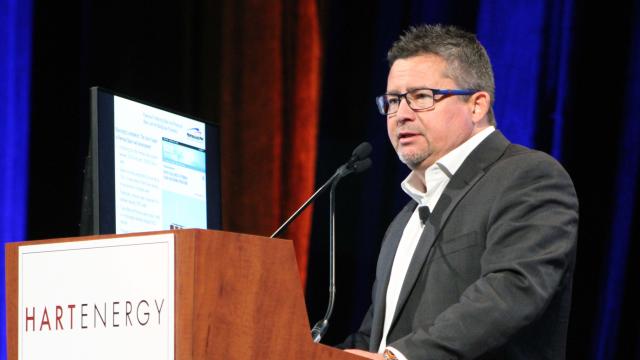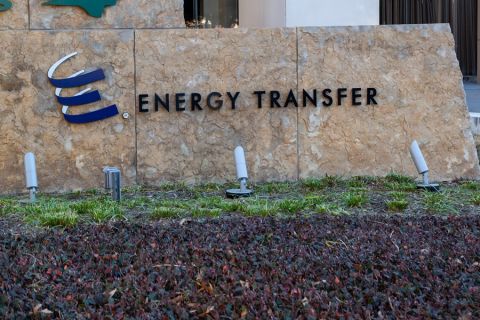
Wes Long, technical projects director for Dallas-based Chevron Phillips Chemical Co., discusses water handling at Midstream Texas in Midland. (Source: Joe Markman/Hart Energy)
MIDLAND, Texas—There’s water—and then there’s water.
The attributes of produced water, in particular, vary widely, and pipe suppliers are working to respond to the sector’s needs as water production from unconventional reservoirs surges.
Wes Long, technical projects director for The Woodlands, Texas-based Chevron Phillips Chemical Co., described how the plastic pipe manufacturer has developed specialized pipe designed to safely handle high-temperature and high-mineral content water streams.
Polyethylene remains the pipe of choice for saltwater disposal (SWD) systems since brackish water corrodes steel pipe quickly.
RELATED ARTICLES:
- Industry Insights For A New (And Sometimes Hostile) Congress
- Midstream Texas: Plotting The Path From Permian To Gulf Coast (And Beyond)
“I cannot emphasize how important this is,” Long told attendees June 6 at Hart Energy’s Midstream Texas conference and exhibition here. A lack of water-handling pipelines leads to excessive truck traffic and as a result, the Permian Basin in particular, “has more accidents than high-risk countries, and more than anywhere else in this country.
“Trucks filled with Permian water sit idle in traffic, or in backlogged saltwater disposal facilities,” he added. “Economic, safety, environmental and poor road infrastructure issues create pressure to find better, immediate solutions.”
Also, brine spills rate create significant environmental problems, Long said, noting damage from saltwater spills may linger for decades—far longer than crude oil spills, which typically can be remediated. “You can scrape and clean the crude,” in a fairly short amount of time, he said.
SWD looms as a major, and ongoing, “bottleneck” for the shale plays overall, he added. He noted some unconventional plays, including portions of the Delaware Basin produce water at a 15:1 ratio to oil.
“We’re pressured to find solutions,” he said of Chevron Phillips.
Long focused his presentation on South Texas’ Eagle Ford play, noting its wells produce at high temperatures close to the boiling point of water at atmospheric pressure. “That produces significant wear and tear on SWD systems,” he added.
In response, Chevron Phillips developed its PE4710 polyethylene pipe, adapted from a radiant heat pipe originally designed for use in home heating systems. It can withstand routine temperatures of 180 degrees Fahrenheit, with intermittent temperatures of 203 degrees Fahrenheit.
Another unique problem in the Eagle Ford comes from the region’s popularity with hunters. Many ranchers in the region lease out their property during the October-February deer hunting season—and hunters do not like heavy truck traffic that disturbs the region’s wildlife. That makes new SWD systems very popular.
He estimated that new water-handling systems have eliminated 750 truck trips a day in the Eagle Ford, “and that makes for happy landowners.” That’s in addition to improved air quality as all those diesel engines come off area highways, Long noted.
His Eagle Ford discussion focused on the SWD operations of a Chevron Phillips customer: EVX Midstream Partners LLC. The firm has more than 200 miles of SWD gathering and disposal lines in place and is building more. It has 89 truck bays at 26 SWD sites with a combined capacity of 600,000 barrels per day.
It holds long-term, fee-based contracts with producers with more than 800,000 acres under lease and continues to grow its SWD assets, he said.
Paul Hart can be reached at pdhart@hartenergy.com.
Recommended Reading
For Sale? Trans Mountain Pipeline Tentatively on the Market
2024-04-22 - Politics and tariffs may delay ownership transfer of the Trans Mountain Pipeline, which the Canadian government spent CA$34 billion to build.
Energy Transfer Announces Cash Distribution on Series I Units
2024-04-22 - Energy Transfer’s distribution will be payable May 15 to Series I unitholders of record by May 1.
Balticconnector Gas Pipeline Back in Operation After Damage
2024-04-22 - The Balticconnector subsea gas link between Estonia and Finland was severely damaged in October, hurting energy security and raising alarm bells in the wider region.
Wayangankar: Golden Era for US Natural Gas Storage – Version 2.0
2024-04-19 - While the current resurgence in gas storage is reminiscent of the 2000s —an era that saw ~400 Bcf of storage capacity additions — the market drivers providing the tailwinds today are drastically different from that cycle.



